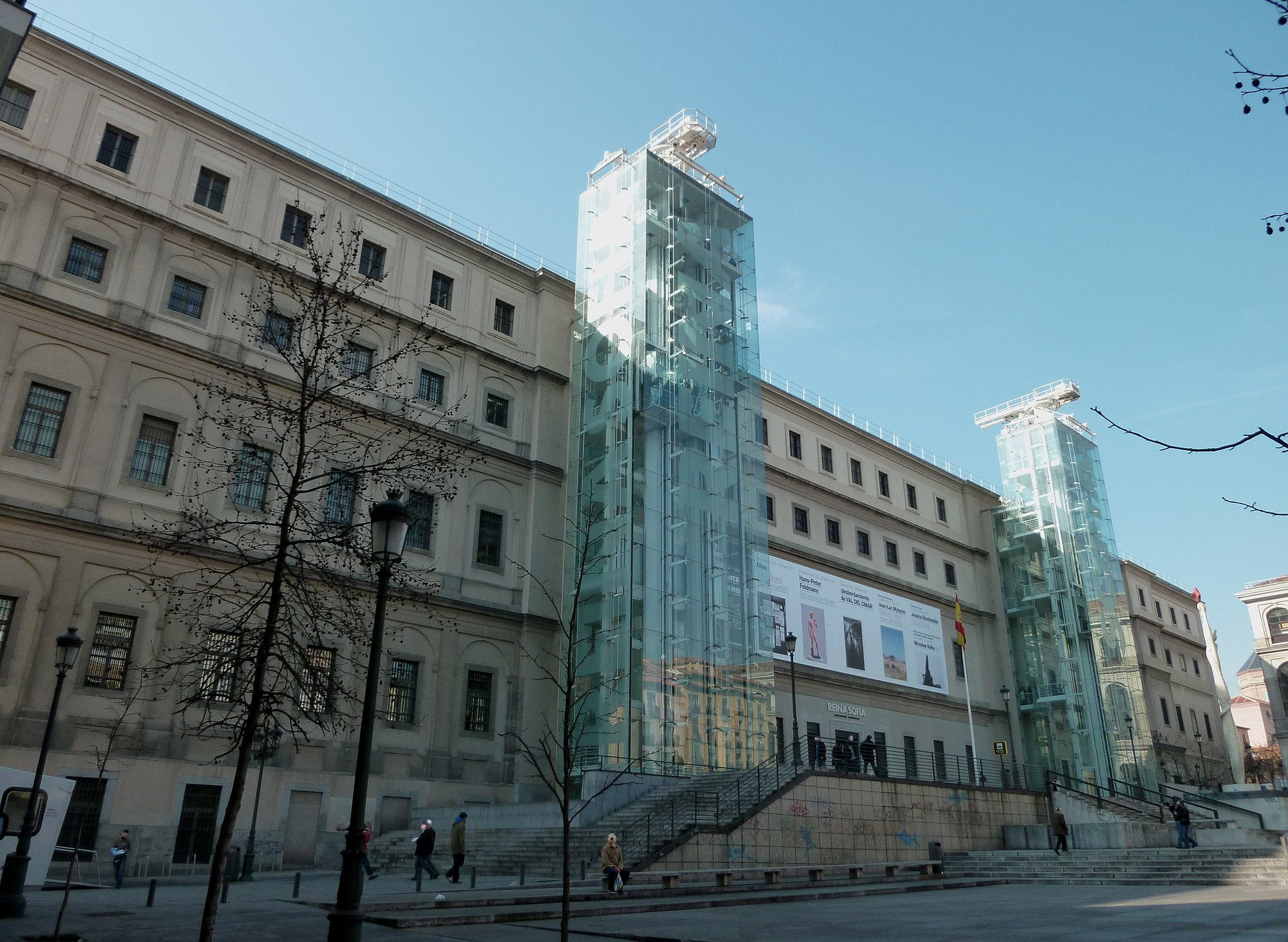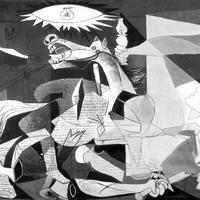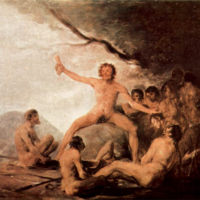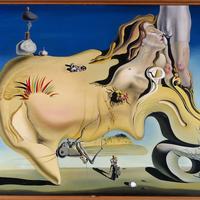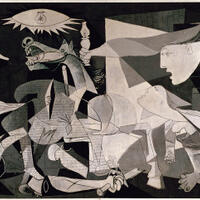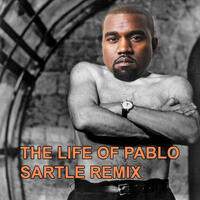More about Museo Nacional Centro de Arte Reina Sofía
Works at Museo Nacional Centro de Arte Reina Sofía
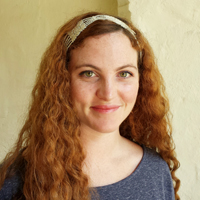
Sr. Contributor
The Queen Sofia Arts Center is home to some of Spain’s best art, a namesake rife with family scandal, and the bloodcurdling screams of tortured souls.
The museum is named after Queen Sofia, the Queen consort of Spain who has kept her title even after her son Felipe VI took over as King in 2014. Queen Sofia was born into Greek Royalty and is perhaps best known for being a distant cousin of Queen Elizabeth, having a cold and philandering husband, and being well dressed. She also speaks seven languages and was a reserve Olympic sailor but whatever, scandals! In 2012, her husband King Juan Carlos faced extreme criticism from his people when he was caught on an expensive elephant hunt while the Spanish were in the midst of economic upheaval and he was an honorary president of the World Wildlife Foundation. He was quoted as saying, “let them eat cake!” He also was brought to court over allegations of fathering an illegitimate daughter while his own daughter, Princess Cristina, was being tried for tax fraud. Great Royaling guys!
The Queen Sofia Arts Center is located near the Paseo del Prado and along with the Prado and Thyssen- Bornimsza Museum is one-third of Madrid’s “Golden Triangle of Art.” This is a coincidentally fitting name when considering that it was during Spain’s “Golden Age” that King Phillip II created the Court’s first centralized hospital on the grounds of which the museum now sits. Though that original building has been lost to time, the Sabatini Building opened as a hospital in 1788 and named after one of its architects is still standing and features much of the Museum’s collection. The Sabatini Building was shuttered in 1965, considered for demolition, and eventually marked as a historical site worthy of a museum with restoration beginning in 1980 and the museum officially created by Royal Decree in 1988.
All of the information above is found in the history page on the museum’s website and it’s fine…if you lack imagination. Luckily, I watch an unhealthy amount of horror movies and know that old hospitals= hella ghosts. Using Scooby-skills you can find numerous reports of the Museum’s spooky happenings and dark history. Supposedly the area chosen by King Phillip II was called “El Olivar de Atocha” (the Atocha Olive Grove) and was known for being covered in the city’s scummiest, poorest inhabitants left to die in the streets of plague, cholera etc. The building was never quite completed as planned and with up to 18,000 patients in a mismanaged space one imagines how things might have gone awry. During the conversion of the building to a museum workers reportedly found skeletons, chains and shackles, and the mummified corpses of three nuns in the Chapel walls. News of a group of paranormal researches and psychics reportedly hired by the Museum to investigate staff complaints of unexplained screams from empty rooms, and elevators and doors with minds of their own was released in the April 1995 issue of Spanish news source Diario 16. The researchers concluded that certain rooms were used as torture chambers during the Spanish Civil War and others to chain the mentally ill to walls. More like Fright at the Museum, amiright?
Haunted or not, this museum is definitely worth a visit. Go for Guernica but stay for the other 20,000 works in the collection because they are all awesome. As it houses one of the world’s most famous works of art, advanced tickets are recommended and can be purchased on the museum’s website. If you plan on visiting the “Golden Triangle’s” other sites in one day we strongly recommend you download and use The Essential Art Walk app linked on the museum’s visitor page in order to maximize your time by providing directions on hitting the 8 most important works at each location. The app also provides additional information on each piece, which you can of course supplement with your Sartle reading.
Sources
- Fiona Govan, “Spain will have two kings and two queens,” The Telegraph. June 13th, 2014. Accessed March 29th, 2017. http://www.telegraph.co.uk/news/worldnews/europe/spain/10898873/Spain-w…
- Harriet Alexander, ”Queen Sofia of Spain: Europe’s lonely royal consort,” The Telegraph. May 20th, 2012. Accessed March 29th, 2017. http://www.telegraph.co.uk/news/worldnews/europe/spain/9276931/Queen-So…
- Naina Bajekal, “Former Spanish King Juan Carlos Faces a Paternity Suit,” Time. January 15th, 2015. Accessed March 29th, 2017. http://time.com/3668856/spain-king-juan-carlos-paternity-suit/
- Annabel Fenwick Elliot, “That’s awkward! Queen Letizia of Spain and her mother-in-law Queen Sofia wear MATCHING beige outfits,” Daily Mail. September 29th, 2015. Accessed Match 29th, 2017. http://www.dailymail.co.uk/femail/article-3253413/Queen-Letizia-S
- “Royal Participants at the Olympics,” Topendsports, accessed March 29th, 2017. http://www.topendsports.com/events/summer/athletes/royals.htm
- “Row over hunting trip for Spanish King Juan Carlos,” BBC. April 16th, 2012. Accessed March 29th, 2017. http://www.bbc.com/news/world-europe-17730857
- Naina Bajekal, “Former Spanish King Juan Carlos Faces a Paternity Suit,” Time. January 15th, 2015. Accessed March 29th, 2017.
- Naina Bajekal, “Spanish King’s Sister to Stand Trial on Tax Fraud Charges,” Times. December 21st, 2014. Accessed March 29th, 2017. http://time.com/3643655/spain-king-sister-cristina-borbon-tax-fraud/
- “History,” Museo Nacional Centro de Arte Reina Sofia, Accessed March 29th, 2017. http://www.museoreinasofia.es/en/museum/history
- Keith Pattison de Bellasis, “The Haunting of the Reina Sofia Museum,” Unexplained Mysteries. April 12th, 2014. Accessed March 29th, 2017. http://www.unexplained-mysteries.com/column.php?id=265044
- “Frightened by Ghosts by Moonlight on Tombstones? Part II,” Before it’s News. January 4th, 2014. Accessed March 29th, 2017. http://beforeitsnews.com/paranormal/2014/01/frightened-by-ghosts-by-moo…
- Keith Pattison de Bellasis, “The Haunting of the Reina Sofia Museum,” Unexplained Mysteries. April 12th, 2014. Accessed March 29th, 2017. http://www.unexplained-mysteries.com/column.php?id=265044
- “Visit,” Museo Nacional Centro de Arte Reina Sofia. Accessed March 29th, 2017. http://www.museoreinasofia.es/en/visit
- “The Essential Art Walk App,” Madrid!. Accessed March 29th, 2017. https://www.esmadrid.com/en/essential-art-walk-app
Featured Content
Here is what Wikipedia says about Museo Nacional Centro de Arte Reina Sofía
The Museo Nacional Centro de Arte Reina Sofía ("Queen Sofía National Museum Art Centre"; MNCARS) is Spain's national museum of 20th-century art. The museum was officially inaugurated on September 10, 1992, and is named for Queen Sofía. It is located in Madrid, near the Atocha train and metro stations, at the southern end of the so-called Golden Triangle of Art (located along the Paseo del Prado and also comprising the Museo del Prado and the Museo Thyssen-Bornemisza).
The museum is mainly dedicated to Spanish art. Highlights of the museum include excellent collections of Spain's two greatest 20th-century masters, Pablo Picasso and Salvador Dalí. The most famous masterpiece in the museum is Picasso's 1937 painting Guernica. Along with its extensive collection, the museum offers a mixture of national and international temporary exhibitions in its many galleries, making it one of the world's largest museums for modern and contemporary art. In 2021, due to the COVID-19 pandemic restrictions, it attracted 1,643,108 visitors, up 32 percent from 2020, but well below 2019 attendance. In 2021 it ranked eighth on the list of most-visited art museums in the world.
It also hosts a free-access library specializing in art, with a collection of over 100,000 books, over 3,500 sound recordings, and almost 1,000 videos.
Check out the full Wikipedia article about Museo Nacional Centro de Arte Reina Sofía

